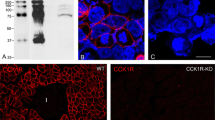Abstract
Pancreatitis-associated protein (PAP) is a lectin-related protein barely detectable in normal pancreas but overexpressed by this tissue during the acute phase of the pancreatitis. We describe in this report that PAP is constitutively expressed in the human intestinal tract. Northern blot analysis with pancreatic cDNA as probe shows the presence of a transcript in the jejunum that has the same electrophoretic mobility as the pancreatic mRNA. No signal was detected in colon, however. In addition, immunoblotting assays, utilizing specific rabbit immunosera prepared against PAP, revealed the presence of a protein of 16,000 Da (as in pancreatic juice) in the homogenate of jejunum, but not of the colon. When the same antibodies were used for tissule localization of the protein, positive immunoreactivity was observed on Paneth cells and in some goblet cells located in jejunum at the bottom of the crypts. No staining was observed in colon.
Similar content being viewed by others
References
Keim V, Iovanna J, Rohr G, Usadel K, Dagorn J-C: Characterization of a rat pancreatic secretory protein associated with pancreatitis. Gastroenterology 100:775–782, 1991
Keim V, Iovanna J, Orelle B, Verdier J-M, Büsing M, Hopt U, Dagorn J-C: A novel exocrine protein associated with pancreas transplantation in humans. Gastroenterology 103:248–254, 1992
Orelle B, Keim V, Masciotra L, Dagorn J-C, Iovanna J: Human pancreatitis-associated protein. Messenger RNA cloning and expression in pancreatic disease. J Clin Invest 90:2284–2291, 1992
Iovanna J, Orelle B, Keim V, Dagorn J-C: Messenger RNA sequence and expression of rat pancreatitis-associated protein, a lectin-related protein overexpressed during acute experimental pancreatitis. J Biol Chem 266:24664–24669, 1991
Giorgi D, Bernard J-P, Rouquier S, Iovanna J, Sarles H, Dagorn J-C: Secretory pancreatic stone protein messenger RNA. Nucleotide sequence and expression in chronic calcifying pancreatitis. J Clin Invest 84:100–106, 1989
Rouquier S, Giorgi D, Iovanna J, Dagorn J-C: Sequence similarity between the reg transcript and pancreatic stone protein mRNA. Biochem J 264:621–624, 1989
Watanabe T, Yonekura H, Terazono K, Okamoto H: Complete nucleotide sequence of human reg gene and its expression in normal and tumoral tissues. The reg protein, pancreatic stone protein, and pancreatic thread protein are one and the same product of the gene. J Biol Chem 265:7432–7439, 1990
Drickamer K: Two distinct classes of carbohydrate-recognition domains in animal lectins. J Biol Chem 263:9557–9560, 1988
Iovanna J, Frigerio J-M, Dusetti N, Ramaré F, Raibaud P, Dagorn J-C: Lithostathine, and inhibitor of CaCO3 crystal growth in pancreatic juice, induces bacterial aggregation. Pancreas 8:597–601, 1993
Iovanna J, Keim V, Bosshard A, Orelle B, Frigerio J-M, Dusetti N, Dagorn J-C: PAP, a pancreatic secretory protein induced during acute pancreatitis, is expressed in rat intestine. Am J Physiol 265:G611-G618, 1993
Chirgwin JM, Przybyla A, MacDonald RJ, Rutter WJ: Isolation of biologically active ribonucleic acid from sources enriched in ribonuclease. Biochemistry 24:5294–5299, 1979
Maniatis T, Fritsch EF, Sambrook J: Molecular Cloning: A Laboratory Manual. Cold Spring Harbor, New York, Cold Spring Harbor Laboratory, 1982, 545 pp
Feimberg AP, Volgestein B: A technique for radiolabelling DNA restriction endonuclease fragments to high specific activity. Anal Biochem 132:6–13, 1983
Kyhse-Andersen J: Electroblotting of multiple gels: a simple apparatus without buffer tank for rapid transfer of proteins from polyacrylamide gels. Biochem Biophys Methods 10:203–209, 1984
Sternberger LA: Immunocytochemistry, 2nd ed. New York, Wiley, 1979, pp 104–169
Senegas-Balas F, Balas D, Bouisson M, Ribet A: Effect of pancreatic duct ligation on the hamster intestinal mucosa. Variations of several hydrolases. Digestion 21:83–91, 1981
Bohe M, Borgstrom A, Lindstrom C, Ohlsson K: Trypsin like immunoreactivity in human Faneth cells. Digestion 30:271–279, 1984
Bohe M, Borgstrom A, Lindstrom C, Ohlsson K: Pancreatic endoproteases and pancreatic secretory inhibitor immunoreactivities in human Paneth cells. J Clin Pathol 39:786–793, 1986
Lechêne de la Porte P, Lafont H, Lombardo D: Immunocytochemical localization of pancreatic carboxyl ester hydrolase in human Paneth cells. Histochemistry 86:211–214, 1986
Lechêne de la Porte P, de Caro A, Lafont H, Sarles H: Immunocytochemical localization of pancreatic stone protein in the human digestive tract. Pancreas 1:301–308, 1986
Freeman TC, Playford RJ, Quinn C, Beardshall K, Poulter L, Young J, Calam J: Pancreatic secretory trypsin inhibitor in gastrointestinal mucosa and gastric juice. Gut 31:1318–1323, 1990
Senegas-Balas F, Figarella C, Amouric M, Guy-Crotte O, Bertrand C, Balas D: Immunocytochemical demonstration of a pancreatic secretory protein of unknown function in human duodenum. J Histochem Cytochem 39:915–919, 1991
Trier JS, Lorenzsonn V, Groehler K: Pattern of secretion of Paneth cells of the small intestine of mice. Gastroenterology 53:240–249, 1967
Selsted ME, Miller SI, Henschen AH, Ouellette AJ: Enteric defensins: antibiotic peptide components of intestinal host defense. J Cell Biol 118:929–936, 1992
Deckx RJ, Van Trappen GP, Parein MM: Localization of lysozyme activity in a Paneth cell granule fraction. Biochim Biophys Acta 139:204–207, 1967
Erlandsen SL, Chase DG: Paneth cell function: Phagocytosis and intracellular digestion of intestinal microorganisms. IHexamita muris. J Ultrastruct Res 41:296–318, 1972
Erlandsen SL, Chase DG: Paneth cell function: Phagocytosis and intracellular digestion of intestinal microorganisms. II Spiral microorganism. J Ultrastruct Res 41:319–333, 1972
Ponder BAJ, Schmidt GH, Wilkinson MM, Wood MJ, Monk M, Reid A: Derivation of mouse intestinal crypts from single progenitor cells. Nature 313:689–691, 1985
Cheng H, Leblond CP: Origin differentiation and renewal of the four main epithelial cell types in the mouse small intestine. V. Unitarian theory of the origin of the four epithelial cell types. Am J Anat 141:537–562, 1974
Author information
Authors and Affiliations
Additional information
This work was supported by the French-Argentinian Cooperation Program (INSERM-CONICET). J.-M.F. is supported, in part, by a fellowship from Jouveinal. N.J.D. is supported by a fellowship from the Fondation pour la Recherche Médicale (FRM).
Rights and permissions
About this article
Cite this article
Masciotra, L., Lechêne de la Porte, P., Frigerio, JM. et al. Immunocytochemical localization of pancreatitis-associated protein in human small intestine. Digest Dis Sci 40, 519–524 (1995). https://doi.org/10.1007/BF02064359
Received:
Revised:
Accepted:
Issue Date:
DOI: https://doi.org/10.1007/BF02064359




